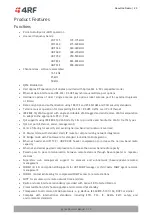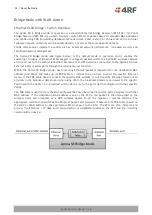
22 | About the Radio
Aprisa SRx User Manual 1.3.0
Repeater Messaging
The Aprisa SR uses a routed protocol throughout the network whereby messages contain source and
destination addresses. The remote and repeater stations will register with a base station. In networks with
a repeater, the repeater must register with the base station before the remotes can register with the base
station.
Additionally, based on destination address, messages are designated as either a ‘broadcast’ message,
(mostly originating from a base station) or a ‘unicast’ message (mostly originating from a remote station).
In a network with a repeater, or multiple repeaters, the base station broadcasts a message which contains
a source address and a destination address. The repeater receives the message and recognizes it is a
broadcast message, from the destination address and re-broadcasts the message across the network. In IP
routing mode all remote stations in the coverage area will receive the message but only the radio with the
destination address will act upon the message.
Similarly, the remote station will send a unicast message which contains a unicast destination address (the
base station). The repeater will receive this message; recognize the destination address and forward it to
the appropriate destination address.
In order to prevent repeater-repeater loops, a detection mechanism of ‘duplicate message’ and use of
unicast messaging in remote to base/repeater direction is used.
For example, in the Multiple Repeater Single Hop figure above, the topology is of Base, Repeater 1,
Repeater 2 and Remote 1 connected to Repeater 1 in overlapping coverage, where Remote 1 can also hear
Repeater 2. When the Base station broadcasts a message, Remote1 will receive this message from both
Repeater 1 and Repeater 2 but will drop one of them as ‘duplicate message’. It is possible that Repeater
1, for example, can also hear the broadcast sent out by Repeater 2. In this case, Repeater 1 will drop this
broadcast as a ‘duplicate message’.
These phenomena will not happen in the upstream direction as all messages are sent ‘unicast’. Remote 1
will send a packet to Base station, setting the destination address in packet to Base station and ‘next hop’
address in packet to Repeater 1. Thus, only Repeater 1 will forward the packet to Base station and
Repeater 2 will drop the packet as the ‘next hop’ address is not Repeater 2.
















































